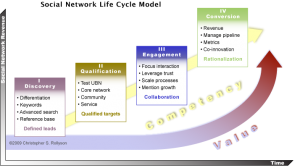1st Opportunity to Use Breakthrough Social Network “Path to Revenue” Tool
I will officially release the “Social Network Life Cycle Model at the Social Networking Conference next month, and we will be using it during my pre-conference workshop on June 24. Participants will use the model to create solid revenue models for their social networking initiatives. The four-stage model features milestones, key processes and outcomes that enable companies to understand and progress through pre-revenue social networking investments—and to predict revenue. Here I’ll give a short preview of the model and how we’ll use it.
ROI vs. IOR
Early champions of enterprise social networking initiatives have been plagued by the difficulty in creating an “ROI” model for their social networking investments. Business executives are accustomed to dealing with mature processes that have known outcomes and defined ROIs, but in 2009, social networking is an innovation proposition. It is an immature process. There are very defined outcomes to social networking—and quantifiable, by the way—but in B2B, revenue usually enters the picture when the relationship has developed enough trust.
Executives often subject innovations to far more rigorous demands than they do for their existing business processes, like business development. In many B2B businesses, it is widely acknowledged that relationships take months to develop, and revenue is produced after a high enough trust level is achieved. With respect to social networking, I call this phase “Invest on Relationship,” IOR.
When using social networks for business, you invest your highest investments in “good prospects” just as you do offline. The difference is, social networks enable you to develop trust more quickly and inexpensively.
The Social Network Life Cycle
 As you can see, the first three stages of the life cycle model are mostly pre-revenue, but each has defined activities and milestones and measurable outcomes. People who use the model gain more confidence in their social networking initiatives and more trust from their colleagues who are more skeptical about social networks’ relevance.
As you can see, the first three stages of the life cycle model are mostly pre-revenue, but each has defined activities and milestones and measurable outcomes. People who use the model gain more confidence in their social networking initiatives and more trust from their colleagues who are more skeptical about social networks’ relevance.
The life cycle is relevant to all kinds of social network investments, whether Twitter, LinkedIn, Facebook or others. In the workshop, we will use it as an integral part of the overall process of planning and managing enterprise social networking initiatives.
Closing Thoughts
- I have developed this model by genericizing tools developed on client engagements, most of which have been B2B-focused and relationship-based businesses.
- In B2C, the model is also relevant, but the context is different. Companies can see revenue much earlier when the purchase is more casual or at a lower price point.
- Here is a more detailed description of the Social Network Life Cycle Model.
- Please share your thoughts, experiences and opinions.

[…] post New Social Network Revenue Model to be Released at L.A. Pre-Conference Workshop appeared first on Christopher S. Rollyson and […]